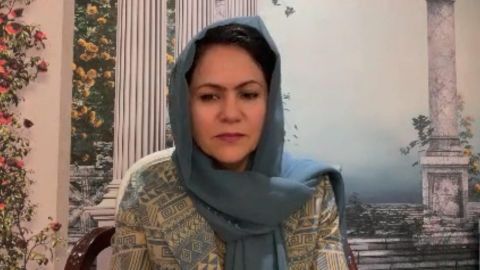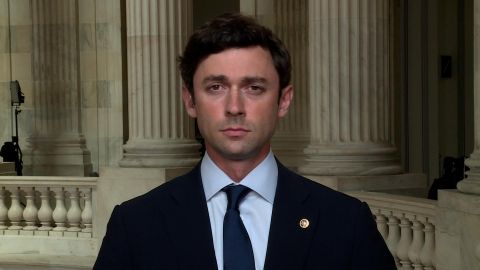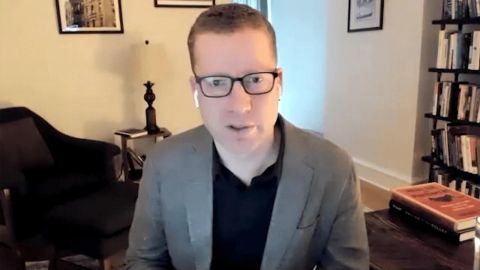Read Transcript EXPAND
CHRISTIANE AMANPOUR: Now, 2020 saw an unprecedented rise in urban crime across the United States. Was this due to the pandemic? Was it in response to the heated discussion surrounding police reform or something else entirely? Fast-forward to today, and protests in Minnesota are into their fifth day over the killing of Daunte Wright, a 20-year-old black man shot by police during a traffic stop on Sunday. Author and sociology professor Patrick Sharkey from Princeton is the founder of AmericanViolence.org. And here he is speaking to Michel Martin about strategies to confront violence.
MICHEL MARTIN: Professor Patrick Sharkey, thank you so much for speaking with us.
SHARKEY: It’s great to be here.
MARTIN: A lot of people are writing about gun violence right now. And a lot of people are writing about police violence right now. I want to dig into each of these crises separately, but are they intrinsically connected, in your view?
SHARKEY: I think they are connected. And this goes all the way back to the late 1960s, when the United States tried a model of dealing with all the challenges that come bundled up when you have extreme urban inequality. We went through a decade where we tried what Johnson called the war on poverty. And we started to make investments in communities. And then we abandoned that approach. And we, as a nation, took a different approach. And our approach consisted of two driving goals. And I lay this out in my book, but one is to leave cities on their own, disinvest, extract resources from communities, ignore the challenges that have become more and more visible in central cities over the last century, over the last 60 or 70 years, and, secondly, invest in a model driven by the goal of punishment. So, invest heavily in the prison system, invest heavily in law enforcement, and really start to rely on law enforcement to respond to all the challenges that come bundled when you have extreme urban inequality. So, that model of abandonment and punishment has been largely intact in the decades since. And I think what we’re seeing, the police violence that has become so visible, has been happening for a very long time we just didn’t have cell phone cameras recording it. So, when — as the whole nation has seen what’s been going on in low-income communities of color for past decades there is less and less tolerance, there’s less and less acceptance that this is how our fellow citizens should be treated.
MARTIN: We can also undeniable that we are experiencing a spasm of gun violence. I mean, there’s been — as I last checked before our conversation, minutes ago, there have been 143 mass shootings since the beginning of the year. Do you think that we are seeing more brutality by police or is it just that the rest of the country outside of the people directly experiencing it are seeing it now?
SHARKEY: Yes. I think the latter. So, police violence has been extremely consistent over time. And this goes back even to a couple decades ago when the number of people killed by police has remained at a very similar level over time, even as the overall level of violence fell from the 1990s all the way through 2014, the level of police violence from the data sources we have looks like it was remarkably stable. And so, what is interesting is that even after all the attention, even after the emergence of the Black Lives Matter movement, even after widespread protests across the country, that level of police violent hasn’t budged. So, the police kill about 1,000 people each year. And even in the past six or seven years, has just — has just gotten extraordinary attention and scrutiny, the number of people killed by law enforcement each year hasn’t changed that much. So, that tells you something about this institution and the stability of the way that police departments operate across the country.
MARTIN: So, you know, I am guessing you take turns being unpopular because the fact is that the right and police unions, which are heavily rightest, even if their members are not, have been pushing the narrative that the social justice protests are leading to this increase in violence. And you suggest that there is actually some evidence to support that. On the other hand, you argue that police conduct does play a role in social instability. So, I want to talk about both of those things. You know, why might protests, the social justice protests we have been seeing, play a role in increased violence? Why might that be?
SHARKEY: There is a pattern when there are high-profile protests against police brutality, against injustice in the criminal legal system or reactions to specific incidence of police violence. It can begin a process where violence rises inside that city, that happened after Freddie Gray incident in Baltimore, it happened after the Michael Brown murder in Ferguson. And the important thing is to not deny that that happens. But it’s to interpret it, and what is actually going on. And there —
MARTIN: Why — of course it is. I mean, come on, conservative politicians and conservative media are saying, you know, of course it is because the police aren’t doing their job as they see their job. So, what do you say?
SHARKEY: Yes. Well, there is one dimension of change, which is police officers changed the way that they do their job. And they may step back and they may do that to make a statement, they may do that because of policy change, they may do that because they are genuinely concerned about what might happen if they get involved in an incident and it goes bad. You know, so, all of those are very real. But then there is a second dimension, which is that after these kinds of incidents, residents in a community are also likely to step back, to disengage, to stop providing information, to stop working with police, to stop calling the police for help. And so, it’s these dual processes that often take place, not always, but often take place in the aftermath of high-profile protests where police may stop doing their job to the same degree and residents may also check out. Then you create the potential for violence to emerge. MARTIN: And what role does police conduct in your view play in this instability?
SHARKEY: Well, it plays a central role but I don’t place blame entirely on police departments in the sense that this is the role that we as a society have asked police to play. So, when we as a nation decided, no we are not going to invest to respond to the challenges that come with concentrated poverty, we are not going to invest to the respond of the challenge of homelessness and addiction and substance abuse. Instead, we are going to invest in law enforcement. Instead, we are going to ask police to respond the all of these challenges. This is what we’ve asked law enforcement to do and we have relied on the police and the actors within the prison system to play this role for such a long time that I do think it’s unfair to ask police to do all of that. And then when we see how this actually looks and practice to call it all off without making the sufficient investments that you need to make in other actors and other institutions who can step up and play a bigger role. So, we’ve created the conditions for this kind of police brutality.
MARTIN: You also pointed out in your case, as you said, that research shows that when violence increase, Americans of all races become more punitive, support harsher policing, criminal justice policies. I think what you’re saying is, you know, some of the same folks who are out protesting on the streets now are going to be people supporting more — (INAUDIBLE) return to the kinds of tactics that people now say they no longer want. Is there an example of that you can point to?
SHARKEY: So, as we’ve seen this surge of violence over the past year, the argument I’m making is that this makes everything more difficult because there is a natural tendency when there is an increase in violence in the U.S., our default response is to turn back to police and say, OK, we need to reinvest in law enforcement. So, Atlanta, for instance, there’s just a new proposal from the mayor to add 250 police officers. This is our automatic response and it’s been our automatic response for the past 50 years and it reflects something deeper about the United States. We have never taken seriously the idea that community residents and community organizations can play a central role in keeping their community safe and also building stronger neighborhoods. We’ve never taken that idea seriously despite lots of evidence suggesting that residents and local organizations have tremendous capacity to control violence. We’ve just never made a commitment to those groups and given them the resources to play that role in a sustainable way.
MARTIN: I mean, what role does race play then? Like I can’t help but notice that, you know, Dylann Roof kills night people in Charleston, South Carolina and walks away and the police officers buy him a hamburger on the way to taking him to jail. I can’t help but notice that the same guy who kills eight people in Atlanta, you know, right guys, somehow is apprehended sort of peacefully. And yet, a guy who’s been stopped for traffic violations, for having air fresheners on his rearview mirror ends up dead. And so, you know, people notice those kinds of things. And so, you do have to ask, is there just something fundamentally racist about the way policing is done in this county?
SHARKEY: Well, I think there is a fundamental connection and the best book on this is Khalil Gibran Muhammad’s book, “The Condemnation of Blackness,” where he kind of points out throughout history how blackness has been defined as criminal or linked with criminality through policy but also through our statistics, through the way we that we measure crime and violence. And this continues throughout U.S. history. So, there is that deep connection. And race certainly is at the heart of any discussions about how we respond to urban inequality more generally. So, I think it’s fundamental. I think that that connection is intrinsic in a lot of ways. We’ve never solved or responded to the problem of racial injustice. We’ve never responded to the problem of racial inequality in the U.S. So, when we choose, as a society, to respond to all of these challenges with the police in the present, there becomes this strong connection between the challenge of racial inequality and the problem of police brutality that’s very clear. MARTIN: And what role does the large presence of guns play in the society? Although, I do have to point out again, you know, white men are more likely to own a gun than any other demographic group. And yet, they are not, by and large, the people who are being killed by police. I mean, while it is true that more white people than I think many people realize are killed by police, overwhelmingly, the white people killed by police are armed. Overwhelmingly, the black people killed by police are not. And so, I just have — but I do think it is fair to ask, what role does the prevalence of guns in the society play and that kind of calculation?
SHARKEY: I think it plays a central role. So, what we know is just from a descriptive sense places that have more guns in circulation have more police killings. And also, all officers are more likely to be killed by gunfire in places that have more guns. So, just at that basic level, there is this relationship that where there are more guns in circulation there is a greater risk that comes with every interaction between a resident and a police officer. There was an incident last week where an officer was shot and killed in New Mexico during a traffic stop and. And, you know, I make the point that that incident is salient to the conversations were having, just as salient as the murder of Dante Wright in the sense that these two incidents are interconnected and it’s not an excuse, it’s not justifying police violence by any stretch of the imagination. But when there is a threat of violence or at least a perceived threat of violence that comes with interactions between law enforcement and residents, then everything becomes more dangerous. Then the potential for a shooting to happen increases substantially. So, you have to consider how the prevalence of guns in the U.S. plays into that and how it makes everything about these discussions of police reform more complex and more difficult. MARTIN: How did you get interested in this particular area of study? I mean, again, I go back to that because you’re tying things together that I think many people intrinsically feel might be connected but they don’t know why, and I’m just wondering what got you started thinking this way.
SHARKEY: Yes. For me, it was one study. So, I did a study out of curiosity about — it was published in 2010. And I was just trying to understand what happens in neighborhoods with high levels of advantage or high levels of disadvantage that seems to have such an impact on the trajectory of kids. And I carried out this one study just to explore, I looked at how kids perform on tests of cognitive skills if they happen to be given that assessment just before there is a major incident, a violence near their home or just after. And that first study that I did show that the kids who by pure chance who took these assessments just after a major incident, a homicide occurred down the street, performed at a level where it looked like they had missed the last two years of schooling. So, the drop in performance was so substantial that I thought it was wrong, it must have been wrong. So, I replicated it and then I did a few other studies with colleagues, and this finally kept repeating itself that when there is violence in a community it changes the functioning of everyone within that community. It makes children less able to function, to focus in school and it ultimately has impacts, not just on children, but on the entire community. And, you know, I look at that our policy discussions and I don’t know that that’s adequately reflected in how we talk about American and equality. MARTIN: So, why is this country so accepting of this level of violence, especially when it affects certain people?
SHARKEY: There’s a longstanding pattern of this. If this is seen as a problem that’s unique to central cities, if this is seen as a problem that affects black communities, then it does not generate the same mobilization, the same commitment, the same investment. So, it’s — there’s a fundamental connection between American racism and the way that we respond to the challenge of violence and I think that’s very visible in social policy over time. If this is seen as a black problem, then it will not receive the same investment that other social problems might generate.
MARTIN: But is there a way forward here as a person who’s been working in this field for a long time, is there anything that gives you a sense of optimism that perhaps the country is willing to address this in a serious way?
SHARKEY: Yes. Well, I think we have a moment of opportunity here. And I wrote a report with Elizabeth Glazer, who is former director of the mayor’s office of Criminal Justice in New York. And what we’re arguing in that report is that this — there is a window to take a different approach to deal with the challenge of violence, to really begin to invest in a new model that begins with community organizations and residents as a central actor who are asked to respond to violence but also given the resources that they need to do that in a sustainable way. And the reason there maybe room for hope is because activists who have been working on the ground for a long time are making this call in a very effective way at this moment. So, a group called Fund Peace, which is a coalition of violence prevention organizations from around the country, played a central role in advocating for an expanded federal investment in new approaches to dealing with violence said, don’t center law enforcement. And at least in the proposal for the American Jobs Plan from the Biden administration, there’s a $5 billion investment in community-based programs designed to confront violence. I have no idea whether this will end up in the final legislation as it appears in the proposal, but it gives me hope because it’s a fundamental departure from the way that we have responded to violence for the past 50 years, which is to double down and invest exclusively in law enforcement and the prison system. This is a different approach. This is investing in the organization and the residents who have always have the greatest capacity to confront violence but who have never been given that same commitment.
MARTIN: Professor Patrick Sharkey, thank you so much for talking with us today.
SHARKEY: It was great talking with you. Thanks for having me.
About This Episode EXPAND
Fawzia Koofi; Jon Ossoff; Patrick Sharkey; Diane Warren; Laura Pausini
LEARN MORE



